Design and Implementation of an Autonomous Climbing Robot Project
VerifiedAdded on 2020/02/24
|9
|1827
|47
Project
AI Summary
This project report details the design and implementation of an autonomous climbing robot, focusing on its ability to navigate rough terrains autonomously. The project's objectives included determining working principles, evaluating hardware components, integrating appropriate designs, developing kinematic designs, and testing smooth motion. The student's area of work involved implementing the hardware architecture, documenting the project, and conducting tests. The report describes the robot's design, which utilized a four-limb structure, cameras, and force sensors for climbing. The student applied engineering knowledge in motion control, using formulas to determine reaction forces and a 6-channel controller board for controlling the robot's movements. The project faced issues with motion planning and multi-contact force control, which were addressed through the study of quasi-static climbing and adjustment of forces. The student also focused on preventing slippage by refining the algorithm. This project showcases collaborative work with team members and a supervisor, highlighting the development and testing of a free climbing robot capable of navigating both vertical and planar terrains.
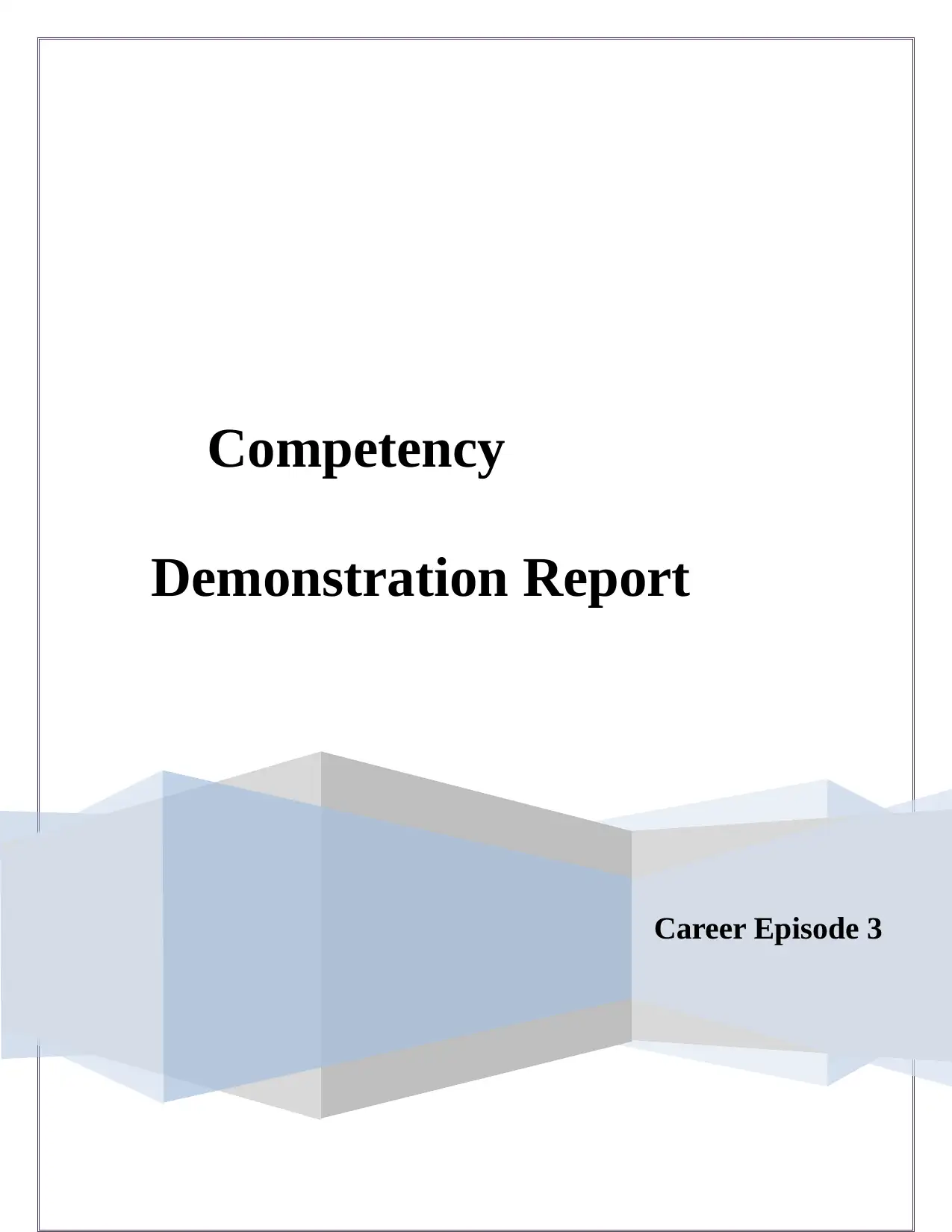
Career Episode 3
Competency
Demonstration Report
Competency
Demonstration Report
Paraphrase This Document
Need a fresh take? Get an instant paraphrase of this document with our AI Paraphraser

CE 3.1 Project Information
Name of the project : Design And Implementation Of An Autonomous
Climbing Robot
Location of the project : [PLEASE FILL]
Project Duration : [PLEASE FILL]
Organization : [PLEASE FILL]
Role and Designation : Team Member
CE 3.2 Project Background
CE 3.2.1 Characteristics of the project
I have observed that the comparing the design of various robots, the development of the
legged robots capable of walking on the terrains is not developed to a significant level. Robots
are used for locomotion in various type terrain including regular, horizontal, flat, or rough
terrain. Various types of robots has been developed and designed based on the specification for
legged robots for navigating through the obstacle and collision while maintaining the
equilibrium. Therefore, in this project, I have aimed at developing a prototype model for the free
climbing, autonomous robot. Therefore the proposed robot has the capability to climb rough
terrain using autonomous technique. I have observed that the robot needs to be in contact with
the terrain and hold the terrain in various ledges, cracks and holes for moving forward. I have
Page 1 of 9
Name of the project : Design And Implementation Of An Autonomous
Climbing Robot
Location of the project : [PLEASE FILL]
Project Duration : [PLEASE FILL]
Organization : [PLEASE FILL]
Role and Designation : Team Member
CE 3.2 Project Background
CE 3.2.1 Characteristics of the project
I have observed that the comparing the design of various robots, the development of the
legged robots capable of walking on the terrains is not developed to a significant level. Robots
are used for locomotion in various type terrain including regular, horizontal, flat, or rough
terrain. Various types of robots has been developed and designed based on the specification for
legged robots for navigating through the obstacle and collision while maintaining the
equilibrium. Therefore, in this project, I have aimed at developing a prototype model for the free
climbing, autonomous robot. Therefore the proposed robot has the capability to climb rough
terrain using autonomous technique. I have observed that the robot needs to be in contact with
the terrain and hold the terrain in various ledges, cracks and holes for moving forward. I have
Page 1 of 9

undertook this project for the development of the wall climbing robot while ensuring the
functionality and performance of the robot.
CE 3.2.2 Objectives developed for the project
In this project I have developed my significant aim for the design and implementation of
the free wall climbing autonomous robot. Therefore, I have focused on integrating special
equipments, sensing system, and robotic motion for detecting the obstacle overhead and climbing
up with the help of limbs. In addition to that, I have divided the entire work for the project
among various objectives for the completion of the robot design and completing the project
within allocated budget. Therefore, following are the lists of objectives that I have developed for
this project are demonstrated in the section below:
To determine the working principle for autonomous wall climbing robot;
To evaluate the hardware components required for the design and development of the
wall climbing robot;
To integrate the appropriate design for the wall climbing robot in rough terrain;
To develop the kinematic design for the robot including the geometric dimension and
overall design;
To test the overall performance of the sooth motion of the designed robot;
CE 3.2.3 My area of work
I was responsible for the implementation of the hardware architecture of the project
module. I had then produced the documentation of the project with the help of the different
modules of the test devices. I had researched the whole research model and created the complete
Page 2 of 9
functionality and performance of the robot.
CE 3.2.2 Objectives developed for the project
In this project I have developed my significant aim for the design and implementation of
the free wall climbing autonomous robot. Therefore, I have focused on integrating special
equipments, sensing system, and robotic motion for detecting the obstacle overhead and climbing
up with the help of limbs. In addition to that, I have divided the entire work for the project
among various objectives for the completion of the robot design and completing the project
within allocated budget. Therefore, following are the lists of objectives that I have developed for
this project are demonstrated in the section below:
To determine the working principle for autonomous wall climbing robot;
To evaluate the hardware components required for the design and development of the
wall climbing robot;
To integrate the appropriate design for the wall climbing robot in rough terrain;
To develop the kinematic design for the robot including the geometric dimension and
overall design;
To test the overall performance of the sooth motion of the designed robot;
CE 3.2.3 My area of work
I was responsible for the implementation of the hardware architecture of the project
module. I had then produced the documentation of the project with the help of the different
modules of the test devices. I had researched the whole research model and created the complete
Page 2 of 9
⊘ This is a preview!⊘
Do you want full access?
Subscribe today to unlock all pages.

Trusted by 1+ million students worldwide
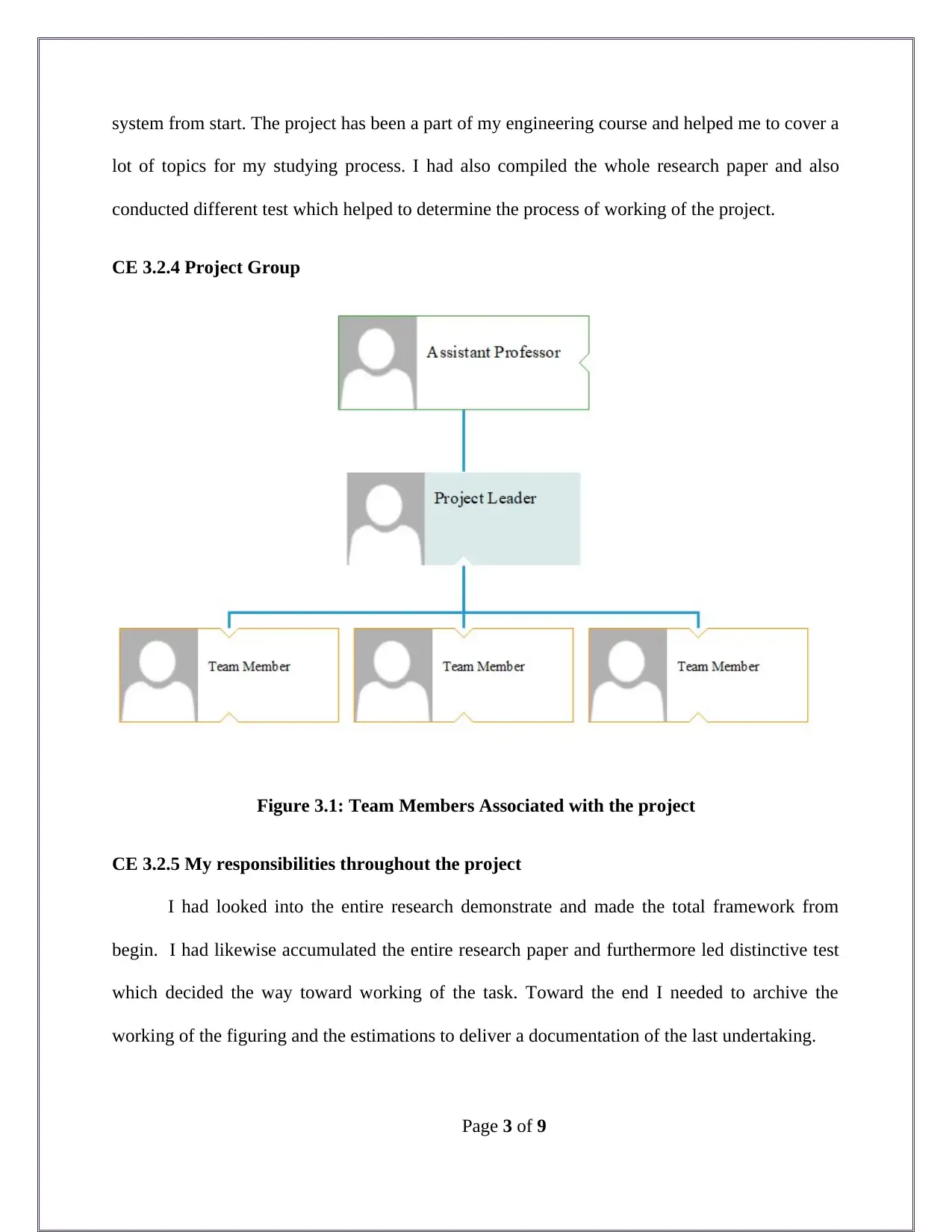
system from start. The project has been a part of my engineering course and helped me to cover a
lot of topics for my studying process. I had also compiled the whole research paper and also
conducted different test which helped to determine the process of working of the project.
CE 3.2.4 Project Group
Figure 3.1: Team Members Associated with the project
CE 3.2.5 My responsibilities throughout the project
I had looked into the entire research demonstrate and made the total framework from
begin. I had likewise accumulated the entire research paper and furthermore led distinctive test
which decided the way toward working of the task. Toward the end I needed to archive the
working of the figuring and the estimations to deliver a documentation of the last undertaking.
Page 3 of 9
lot of topics for my studying process. I had also compiled the whole research paper and also
conducted different test which helped to determine the process of working of the project.
CE 3.2.4 Project Group
Figure 3.1: Team Members Associated with the project
CE 3.2.5 My responsibilities throughout the project
I had looked into the entire research demonstrate and made the total framework from
begin. I had likewise accumulated the entire research paper and furthermore led distinctive test
which decided the way toward working of the task. Toward the end I needed to archive the
working of the figuring and the estimations to deliver a documentation of the last undertaking.
Page 3 of 9
Paraphrase This Document
Need a fresh take? Get an instant paraphrase of this document with our AI Paraphraser
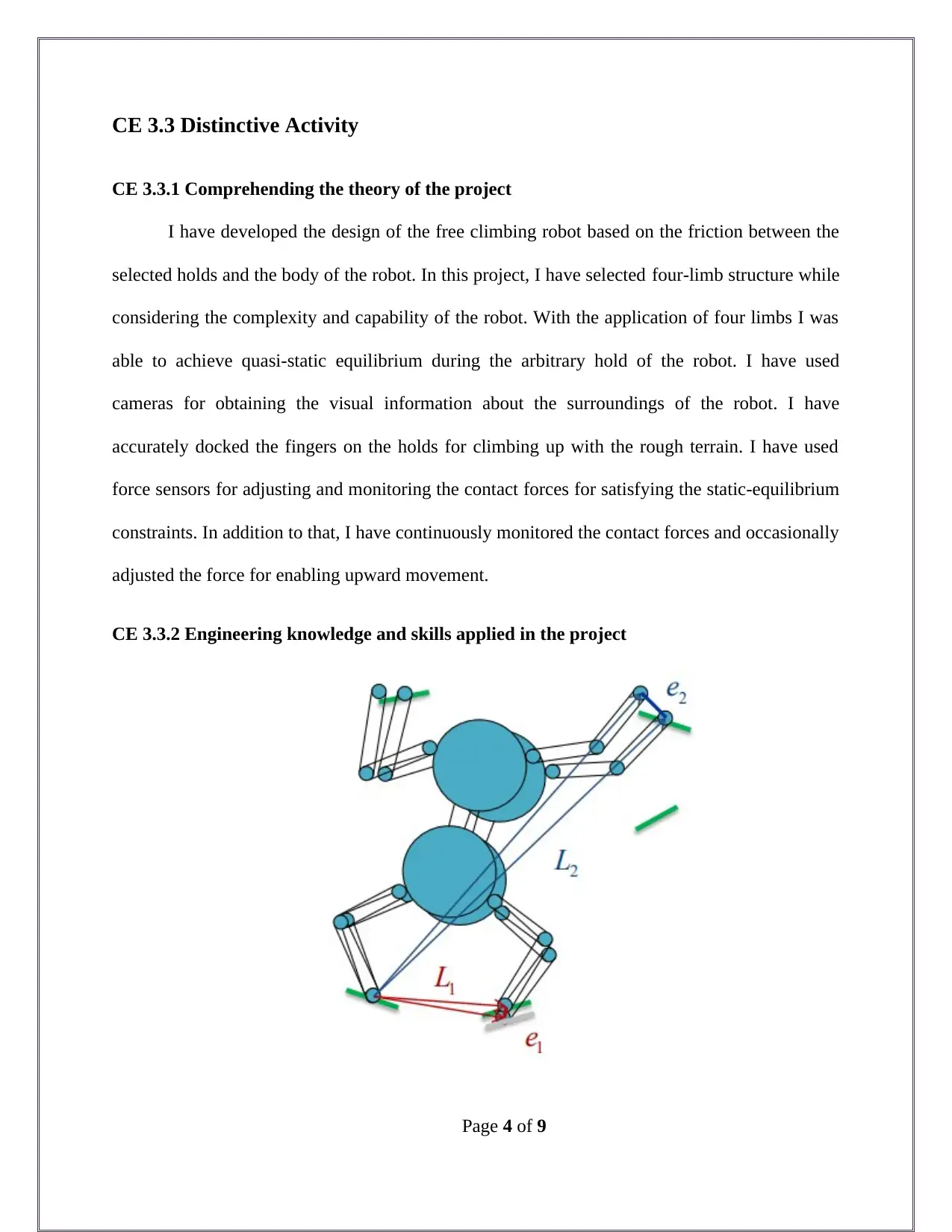
CE 3.3 Distinctive Activity
CE 3.3.1 Comprehending the theory of the project
I have developed the design of the free climbing robot based on the friction between the
selected holds and the body of the robot. In this project, I have selected four-limb structure while
considering the complexity and capability of the robot. With the application of four limbs I was
able to achieve quasi-static equilibrium during the arbitrary hold of the robot. I have used
cameras for obtaining the visual information about the surroundings of the robot. I have
accurately docked the fingers on the holds for climbing up with the rough terrain. I have used
force sensors for adjusting and monitoring the contact forces for satisfying the static-equilibrium
constraints. In addition to that, I have continuously monitored the contact forces and occasionally
adjusted the force for enabling upward movement.
CE 3.3.2 Engineering knowledge and skills applied in the project
Page 4 of 9
CE 3.3.1 Comprehending the theory of the project
I have developed the design of the free climbing robot based on the friction between the
selected holds and the body of the robot. In this project, I have selected four-limb structure while
considering the complexity and capability of the robot. With the application of four limbs I was
able to achieve quasi-static equilibrium during the arbitrary hold of the robot. I have used
cameras for obtaining the visual information about the surroundings of the robot. I have
accurately docked the fingers on the holds for climbing up with the rough terrain. I have used
force sensors for adjusting and monitoring the contact forces for satisfying the static-equilibrium
constraints. In addition to that, I have continuously monitored the contact forces and occasionally
adjusted the force for enabling upward movement.
CE 3.3.2 Engineering knowledge and skills applied in the project
Page 4 of 9

Figure: Motion Control for the wall climbing robot
I have worked in this project for developing accurate control of the motion for the wall
climbing robot. The path for climbing the rough terrain has been developed based on the accurate
computation of the position of the fingers. I have therefore focused on achieving the static
equilibrium for providing precise docking on the robotic arms. In addition to that I have
evaluated the positioning error of the robot. For determining the reaction force on the vertical
component, I have used the following formula:
f = μN
In the above equation, I have used N for determining the horizontal force exerted by the
robot, μ as the coefficient of friction for holding the robot with the terrain. Further, I have used
for determining the reaction force on each of the arm of the robot.
Figure 3: Controller used for designing the robot
Page 5 of 9
I have worked in this project for developing accurate control of the motion for the wall
climbing robot. The path for climbing the rough terrain has been developed based on the accurate
computation of the position of the fingers. I have therefore focused on achieving the static
equilibrium for providing precise docking on the robotic arms. In addition to that I have
evaluated the positioning error of the robot. For determining the reaction force on the vertical
component, I have used the following formula:
f = μN
In the above equation, I have used N for determining the horizontal force exerted by the
robot, μ as the coefficient of friction for holding the robot with the terrain. Further, I have used
for determining the reaction force on each of the arm of the robot.
Figure 3: Controller used for designing the robot
Page 5 of 9
⊘ This is a preview!⊘
Do you want full access?
Subscribe today to unlock all pages.

Trusted by 1+ million students worldwide
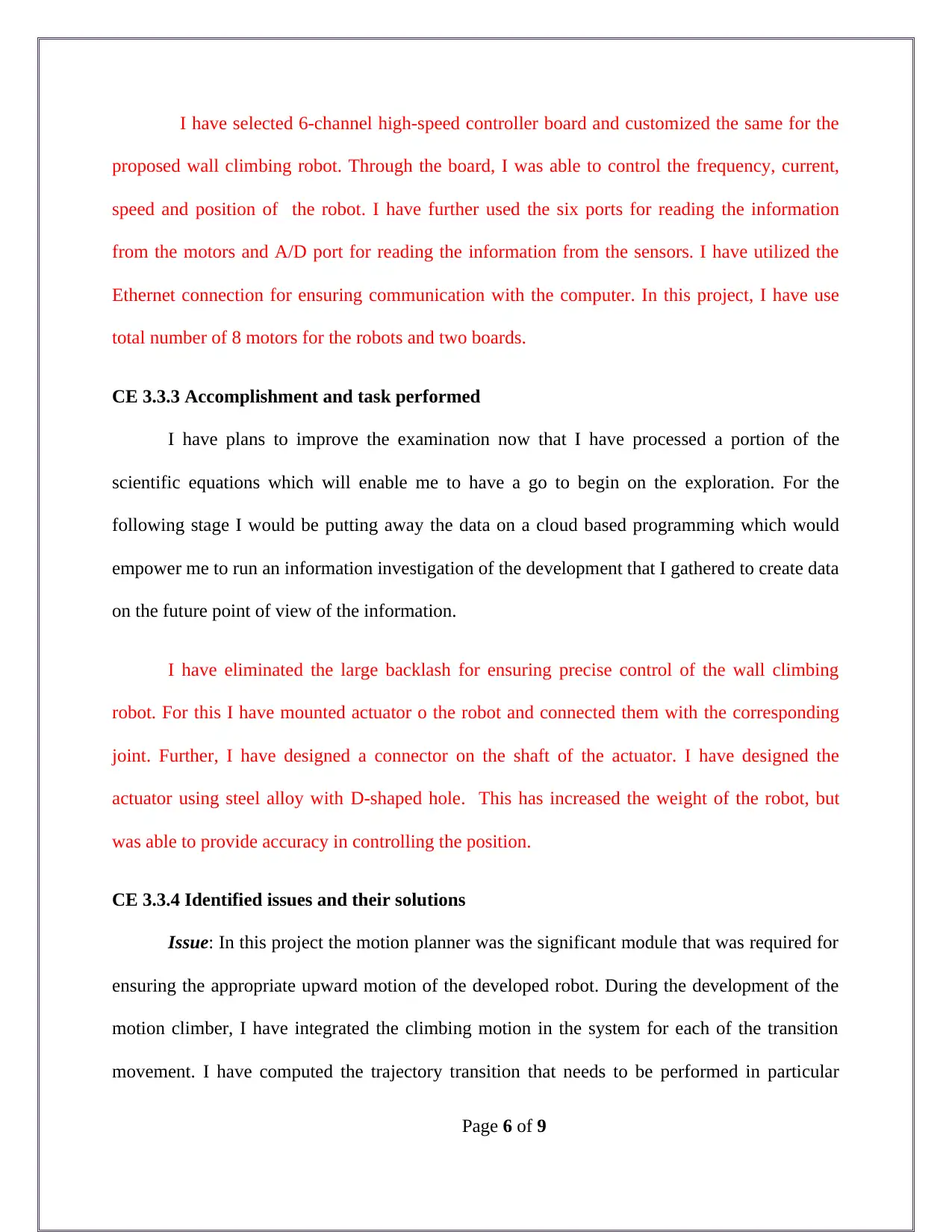
I have selected 6-channel high-speed controller board and customized the same for the
proposed wall climbing robot. Through the board, I was able to control the frequency, current,
speed and position of the robot. I have further used the six ports for reading the information
from the motors and A/D port for reading the information from the sensors. I have utilized the
Ethernet connection for ensuring communication with the computer. In this project, I have use
total number of 8 motors for the robots and two boards.
CE 3.3.3 Accomplishment and task performed
I have plans to improve the examination now that I have processed a portion of the
scientific equations which will enable me to have a go to begin on the exploration. For the
following stage I would be putting away the data on a cloud based programming which would
empower me to run an information investigation of the development that I gathered to create data
on the future point of view of the information.
I have eliminated the large backlash for ensuring precise control of the wall climbing
robot. For this I have mounted actuator o the robot and connected them with the corresponding
joint. Further, I have designed a connector on the shaft of the actuator. I have designed the
actuator using steel alloy with D-shaped hole. This has increased the weight of the robot, but
was able to provide accuracy in controlling the position.
CE 3.3.4 Identified issues and their solutions
Issue: In this project the motion planner was the significant module that was required for
ensuring the appropriate upward motion of the developed robot. During the development of the
motion climber, I have integrated the climbing motion in the system for each of the transition
movement. I have computed the trajectory transition that needs to be performed in particular
Page 6 of 9
proposed wall climbing robot. Through the board, I was able to control the frequency, current,
speed and position of the robot. I have further used the six ports for reading the information
from the motors and A/D port for reading the information from the sensors. I have utilized the
Ethernet connection for ensuring communication with the computer. In this project, I have use
total number of 8 motors for the robots and two boards.
CE 3.3.3 Accomplishment and task performed
I have plans to improve the examination now that I have processed a portion of the
scientific equations which will enable me to have a go to begin on the exploration. For the
following stage I would be putting away the data on a cloud based programming which would
empower me to run an information investigation of the development that I gathered to create data
on the future point of view of the information.
I have eliminated the large backlash for ensuring precise control of the wall climbing
robot. For this I have mounted actuator o the robot and connected them with the corresponding
joint. Further, I have designed a connector on the shaft of the actuator. I have designed the
actuator using steel alloy with D-shaped hole. This has increased the weight of the robot, but
was able to provide accuracy in controlling the position.
CE 3.3.4 Identified issues and their solutions
Issue: In this project the motion planner was the significant module that was required for
ensuring the appropriate upward motion of the developed robot. During the development of the
motion climber, I have integrated the climbing motion in the system for each of the transition
movement. I have computed the trajectory transition that needs to be performed in particular
Page 6 of 9
Paraphrase This Document
Need a fresh take? Get an instant paraphrase of this document with our AI Paraphraser
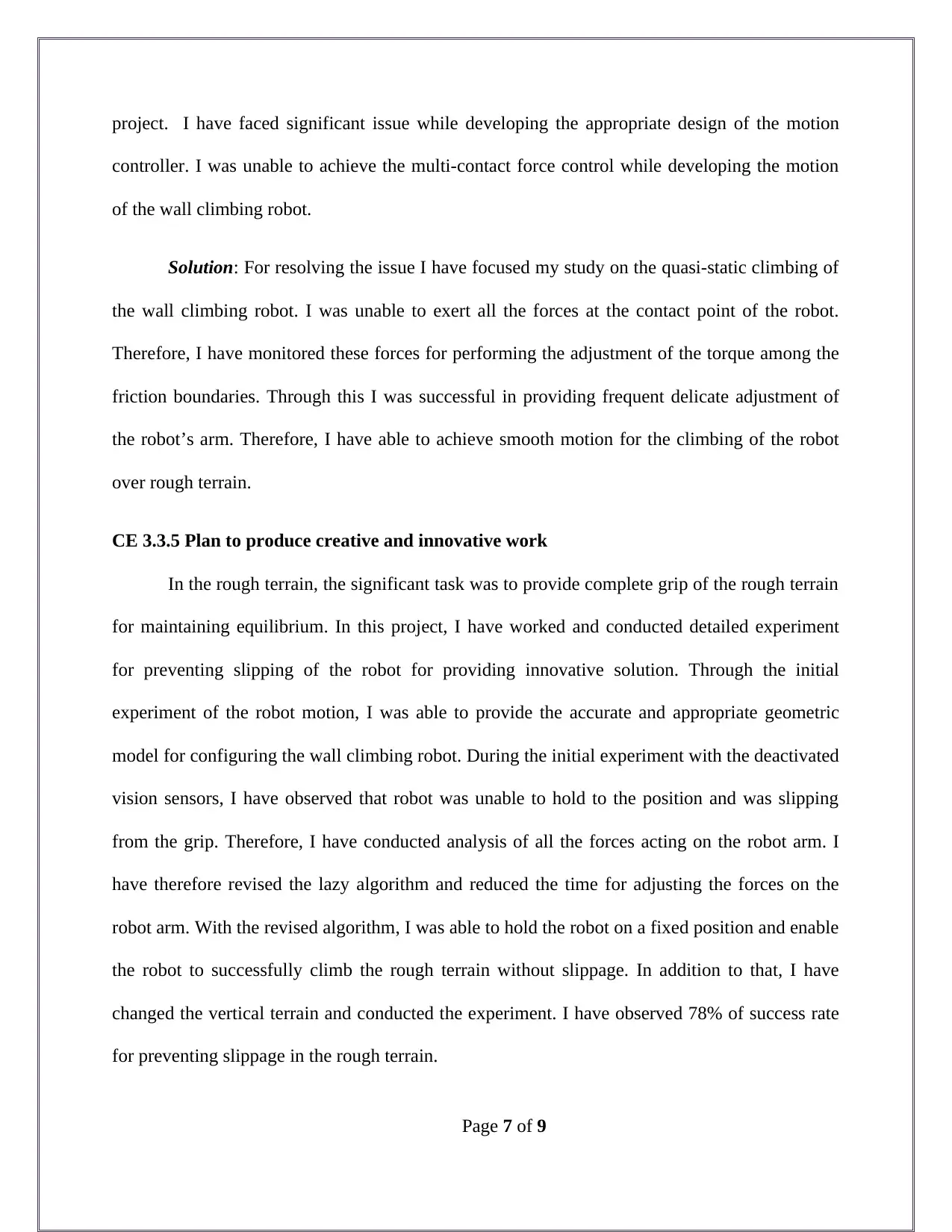
project. I have faced significant issue while developing the appropriate design of the motion
controller. I was unable to achieve the multi-contact force control while developing the motion
of the wall climbing robot.
Solution: For resolving the issue I have focused my study on the quasi-static climbing of
the wall climbing robot. I was unable to exert all the forces at the contact point of the robot.
Therefore, I have monitored these forces for performing the adjustment of the torque among the
friction boundaries. Through this I was successful in providing frequent delicate adjustment of
the robot’s arm. Therefore, I have able to achieve smooth motion for the climbing of the robot
over rough terrain.
CE 3.3.5 Plan to produce creative and innovative work
In the rough terrain, the significant task was to provide complete grip of the rough terrain
for maintaining equilibrium. In this project, I have worked and conducted detailed experiment
for preventing slipping of the robot for providing innovative solution. Through the initial
experiment of the robot motion, I was able to provide the accurate and appropriate geometric
model for configuring the wall climbing robot. During the initial experiment with the deactivated
vision sensors, I have observed that robot was unable to hold to the position and was slipping
from the grip. Therefore, I have conducted analysis of all the forces acting on the robot arm. I
have therefore revised the lazy algorithm and reduced the time for adjusting the forces on the
robot arm. With the revised algorithm, I was able to hold the robot on a fixed position and enable
the robot to successfully climb the rough terrain without slippage. In addition to that, I have
changed the vertical terrain and conducted the experiment. I have observed 78% of success rate
for preventing slippage in the rough terrain.
Page 7 of 9
controller. I was unable to achieve the multi-contact force control while developing the motion
of the wall climbing robot.
Solution: For resolving the issue I have focused my study on the quasi-static climbing of
the wall climbing robot. I was unable to exert all the forces at the contact point of the robot.
Therefore, I have monitored these forces for performing the adjustment of the torque among the
friction boundaries. Through this I was successful in providing frequent delicate adjustment of
the robot’s arm. Therefore, I have able to achieve smooth motion for the climbing of the robot
over rough terrain.
CE 3.3.5 Plan to produce creative and innovative work
In the rough terrain, the significant task was to provide complete grip of the rough terrain
for maintaining equilibrium. In this project, I have worked and conducted detailed experiment
for preventing slipping of the robot for providing innovative solution. Through the initial
experiment of the robot motion, I was able to provide the accurate and appropriate geometric
model for configuring the wall climbing robot. During the initial experiment with the deactivated
vision sensors, I have observed that robot was unable to hold to the position and was slipping
from the grip. Therefore, I have conducted analysis of all the forces acting on the robot arm. I
have therefore revised the lazy algorithm and reduced the time for adjusting the forces on the
robot arm. With the revised algorithm, I was able to hold the robot on a fixed position and enable
the robot to successfully climb the rough terrain without slippage. In addition to that, I have
changed the vertical terrain and conducted the experiment. I have observed 78% of success rate
for preventing slippage in the rough terrain.
Page 7 of 9
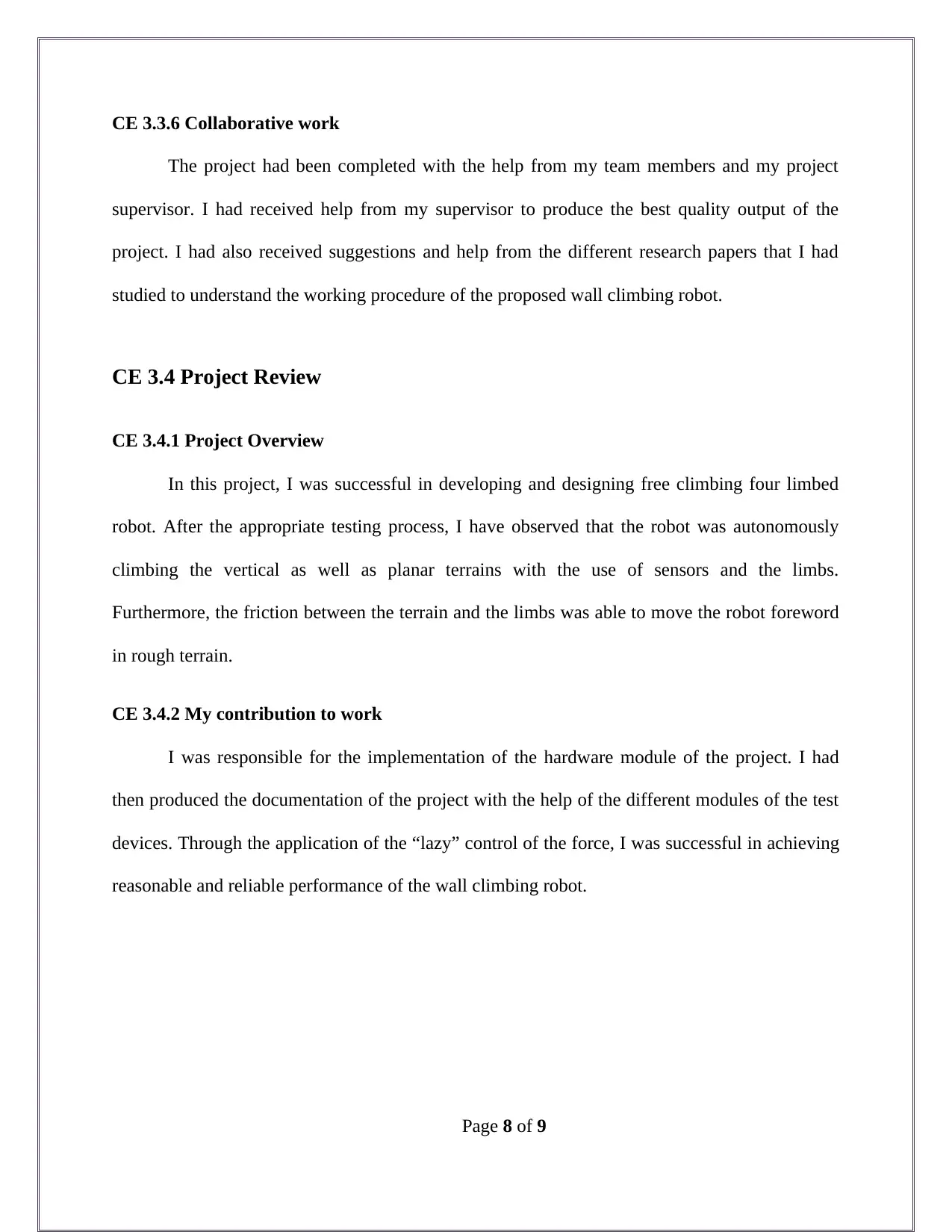
CE 3.3.6 Collaborative work
The project had been completed with the help from my team members and my project
supervisor. I had received help from my supervisor to produce the best quality output of the
project. I had also received suggestions and help from the different research papers that I had
studied to understand the working procedure of the proposed wall climbing robot.
CE 3.4 Project Review
CE 3.4.1 Project Overview
In this project, I was successful in developing and designing free climbing four limbed
robot. After the appropriate testing process, I have observed that the robot was autonomously
climbing the vertical as well as planar terrains with the use of sensors and the limbs.
Furthermore, the friction between the terrain and the limbs was able to move the robot foreword
in rough terrain.
CE 3.4.2 My contribution to work
I was responsible for the implementation of the hardware module of the project. I had
then produced the documentation of the project with the help of the different modules of the test
devices. Through the application of the “lazy” control of the force, I was successful in achieving
reasonable and reliable performance of the wall climbing robot.
Page 8 of 9
The project had been completed with the help from my team members and my project
supervisor. I had received help from my supervisor to produce the best quality output of the
project. I had also received suggestions and help from the different research papers that I had
studied to understand the working procedure of the proposed wall climbing robot.
CE 3.4 Project Review
CE 3.4.1 Project Overview
In this project, I was successful in developing and designing free climbing four limbed
robot. After the appropriate testing process, I have observed that the robot was autonomously
climbing the vertical as well as planar terrains with the use of sensors and the limbs.
Furthermore, the friction between the terrain and the limbs was able to move the robot foreword
in rough terrain.
CE 3.4.2 My contribution to work
I was responsible for the implementation of the hardware module of the project. I had
then produced the documentation of the project with the help of the different modules of the test
devices. Through the application of the “lazy” control of the force, I was successful in achieving
reasonable and reliable performance of the wall climbing robot.
Page 8 of 9
⊘ This is a preview!⊘
Do you want full access?
Subscribe today to unlock all pages.

Trusted by 1+ million students worldwide
1 out of 9
Related Documents
Your All-in-One AI-Powered Toolkit for Academic Success.
+13062052269
info@desklib.com
Available 24*7 on WhatsApp / Email
![[object Object]](/_next/static/media/star-bottom.7253800d.svg)
Unlock your academic potential
Copyright © 2020–2025 A2Z Services. All Rights Reserved. Developed and managed by ZUCOL.





